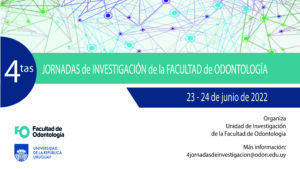Resumen
Introducción: El éxito del tratamiento endodóntico se basa en la interacción de tres niveles de factores: el nivel relacionado con las características del individuo, los factores asociados al órgano dental y los determinantes ligados a los factores del profesional tratante.
Objetivo: Este estudio tuvo como objetivo analizar los factores predictivos respecto al individuo y al diente, que influyen en la sobrevida de dientes tratados endodónticamente por un endodoncista, en un servicio de Uruguay.
Metodología: Estudio observacional, longitudinal y retrospectivo. La muestra consistió en 250 tratamientos endodónticos realizados a partir de la selección de casos que presentaron exámenes de controles periodicos de tratamientos endodónticos, atendidos durante el período comprendido entre enero de 2000 y diciembre de 2015. Se relevaron las características clínicas y radiográficas, junto con los datos demográficos, los factores sistémicos, el grupo dental, la anatomía, el dolor, el estado dental preoperatorio y postoperatorio, el protocolo de preparación, el número de sesiones, la extensión del material de obturación, la calidad de la obturación, los accidentes y el tiempo de proservación y la rehabilitación postratamiento. Los datos se analizaron mediante métodos de regresión logística multivariable y curva ROC en cuanto al potencial de interferencia en la supervivencia de los dientes, considerando un nivel de significación de 0,05.
Resultados: El 84,8% (212) de los dientes tratados tuvieron éxito. Del 15,2% de los tratamientos que fracasaron, la mayor incidencia se produjo en los molares (57%), la curvatura moderada (92,8%) y los 3 canales (50%). El 58,8% de los casos se rehabilitaron en los 90 días posteriores al tratamiento endodóntico. Considerando la variable “grupo dental”, la probabilidad de supervivencia es 4,9 veces menor en premolares y 1,68 en molares. En cuanto a la variable “curvatura”, la moderada tiene 5,48 y la severa 17,02 veces menos probabilidad de éxito. Fumar disminuye las posibilidades de éxito en 2,99 veces. Analizando la variable “rehabilitación recategorizada”, el perno tiene OR 0,81, las resinas/incrustaciones 0,2 y las coronas 0, se comportaron como factores protectores. El modelo mostró una sensibilidad del 86,8% y una especificidad del 58,5%.
Conclusiones: Los predictores que se asociaron a la supervivencia de los dientes tratados endodónticamente fueron el grupo dental (premolares y molares), la presencia de curvatura severa, el tabaquismo y el tipo de rehabilitación dental.
Referencias
2. ALLEY, B.S.; KITCHENS, G.; ALLEY, L.W.; ELEAZER, P.D. A comparison of survival of teeth following endodontic treatment performed by general dentists or by specialists. Oral Surg Oral Med Oral Pathol Oral Radiol Endod, v. 98, n.1, p.115-8, 2004.
3. AMINOSHARIAE, A.; KULLID, J.C.; MICKEL, A.; FOUAD, A.F. Association between Systemic Diseases and Endodontic Outcome: A Systematic Review. J Endod, v.43, p. 514–9, 2017.
4. AQUILINO, S.A.; CAPLAN D.J. Relationship between crown placement and the survival of endodontically treated teeth. J Prosthet Dent, v.87, p.256-63, 2002.
5. AZIM A. A.; GRIGGS J. A.; HUANG, G.T. The Tennessee study: factors affecting treatment outcome and healing time following nonsurgical root canal treatment. Int End J, v.49, p. 6–16, 2016.
6. BALTO, H.A.; ALABDULAALY, L.; BAHAMMAM, S.; AL-EKRISH, A.A. Comparative analysis of prevalence of apical periodontitis in smokers and non-smokers using cone beam computed tomography. The Saudi Dent J, v. 31, n.1, p.52-57, 2019
7. BORÉN D.L.; JONASSON, P.; KVIST, T. Long-term Survival of Endodontically Treated Teeth at a Public Dental Specialist Clinic. J Endod, v. 41, p. 176–181, 2015.
8. CABANILLAS-BALSERA, D.; MARTIN-GONZALEZ, J.; MONTERO-MIRALLES, P.; SNACHEZ-DOMINGUEZ, B.; JIMENEZ-SANCHEZ, M.; SEGURA-EGEA, J.J. Association betweendiabetes and no retention of filled teeth: a systematic review and meta-analysis. Int Endod J, v.52, n. 3, p. 297-301, 2019.
9. FRANCISCATTO, G.J.; KOPPE, B.T.; HOPPE, C.B.; OLIVEIRA, J.A.P.; HAAS, A.N.; GRECCA, F.S.; ROSSI-FEDELE, G.; GOMES, M.S. Validation of self-reported history of root canal treatment in a southern Brazilian population. Braz. Oral Res, v.33, e 007, p. 1- 7, 2019.
10. KHALIGHINEJAD, N.; AMINOSHARIAE, A.; KULID, J.C.; WANG, J.; MICKEL, A. The influence of periodontal status on endodontically treats teeth: 9-year survival analysis. J Endod, v.43, p. 1781-5, 2017 b.
11. MESSING, M.; DE SOUZA, L.C.; CAVALLA, F.; KOOKAL, K.K; RIZZO, G.; WALJI, M.; SILVA, R.; LETRA, A. Investigating potential correlations between endodontic pathology and cardiovascular diseases using epidemiological and genetic approaches. J Endod, v.45, p.104-10, 2019.
12. PRATI, C.; PIRANI, C.; ZAMPARINI, F.; GATTO, M. R.; GANDOLFI, M.G. A 20-year historical prospective cohort study of root canal treatments. A multilevel analysis. Int Endod J, v.51, p.955-68, 2018.
13. SEGURA-EGEA, J.J.; CABANILLAS-BALSERA, D.; JIMENEZ-SANCHEZ, M.C.; MARTIN- GONZALEZ, J. Endodontics and diabetes: association and causation. Int Endod J, v.52,n.6, p.790-802, 2019.
14. SJÖGREN, U.; HAGGLUND, B.; SUNDQVIST, G.; WING, K. Factors affecting the long-term results of endodontic treatment. J Endod, v.16, n.10, p.498-504, 1990.
15. SKUPIEN, J.A.; KREULEN, C.; OPDAM, N.; BRONKHORST, E.; PEREIRA-CENCI, T.; HUYSMANS, M.C. Effect of remaining cavity wall, cervical dentin, and post on fracture resistance of endodontically treated, composite restored premolars. Int J Prosthodont, v. 29, p. 154-6, 2016.
16. TSESIS, I.; GOLDBERGER, T.; TASCHIERI, S.; SEIFAN, M.; TAMSE, A.; ROSEN, E. The Dynamics of Periapical Lesions in Endodontically Treated Teeth That Are Left without Intervention: A Longitudinal Study. J Endod, v.39, p.1510–1515, 2013.


